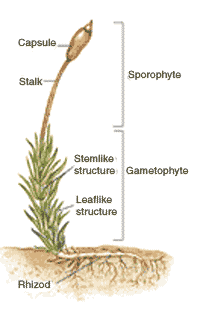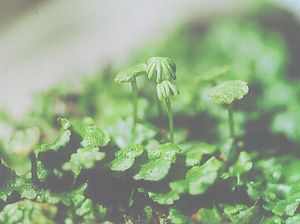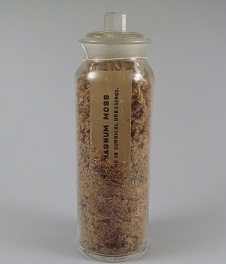Moss: Difference between revisions
Jump to navigation
Jump to search
No edit summary |
No edit summary |
||
| Line 1: | Line 1: | ||
=Overview= | =Overview= | ||
Moss is a group of plants that belong to the division Bryophyta. They are typically 0.2–10 cm (0.1–3.9 in) tall. Moss can be found in any wet envrinment because they rely heavily on water to grow, and reproduce. Rainforests and wetlands are great environments to find moss. They also love the shade, which is why they are found under rocks and at the forest floor. Moss is extremely resilient and can tolerant many toxins, which is why it can also be found in urban areas, growing in cracks in the sidewalk or on the sides of buildings. Moss offers a food source and habitat for invertebrates, it filters toxins out of water, and protects the ground from erosion. | |||
Moss is a group of plants that belong to the division Bryophyta. Moss offers a food source and habitat for invertebrates | |||
=Structure= | =Structure= | ||
| Line 10: | Line 7: | ||
=Life Cycle= | =Life Cycle= | ||
[[File:malefemale.jpg|right|Male and Female Sex Organs|thumb]] | [[File:malefemale.jpg|right|Male and Female Sex Organs [5]|thumb]] | ||
:Moss have two parts to their life cycle. The first part, called ''sporophyte'', is the stage where spores are produced. The spores are carried by wind to populate other areas. The second stage, called ''gametophyte'', is after the spores found a place to grow. They develop male and female sex organs, which allow for reproduction. The male sex organ is an umbrella shaped antheridial head, which contains sperm. The female sex organ is called an archegonial head, which is looks like little fingers, and each finger contains one egg. When it rains, the water splashes the sperm onto the eggs, and the eggs become fertilized. | :Moss have two parts to their life cycle. The first part, called ''sporophyte'', is the stage where spores are produced. The spores are carried by wind to populate other areas. The second stage, called ''gametophyte'', is after the spores found a place to grow. They develop male and female sex organs, which allow for reproduction. The male sex organ is an umbrella shaped antheridial head, which contains sperm. The female sex organ is called an archegonial head, which is looks like little fingers, and each finger contains one egg. When it rains, the water splashes the sperm onto the eggs, and the eggs become fertilized. | ||
=Environmental Role= | =Environmental Role= | ||
:Mosses play an important part in stabilizing soil, and reducing erosion. They have the ability to retain a lot of water, so they create humid environments in which other plants can flourish more easily. | |||
Mosses play an important part in stabilizing soil, and reducing erosion. They have the ability to retain a lot of water, so they create humid environments in which other plants can flourish more easily | |||
=Medical Use= | =Medical Use= | ||
[[File:Sample_sphagnum_for_surgical_dressings_edited.jpg]] | [[File:Sample_sphagnum_for_surgical_dressings_edited.jpg]] | ||
| Line 34: | Line 24: | ||
:[4] “Moss Facts.” Soft Schools, [[https://www.softschools.com/facts/plants/moss_facts/504/]]. | :[4] “Moss Facts.” Soft Schools, [[https://www.softschools.com/facts/plants/moss_facts/504/]]. | ||
:[5] Stein Carter, J. “Primitive Plants: Mosses, Ferns, and Allies.” Biology Clermont, 11 July 2017, [[https://biologyclermont.info/wwwroot/courses/lab2/mosses%20intro.htm]]. | :[5] Stein Carter, J. “Primitive Plants: Mosses, Ferns, and Allies.” Biology Clermont, 11 July 2017, [[https://biologyclermont.info/wwwroot/courses/lab2/mosses%20intro.htm]]. | ||
:[6 | :[6] | ||
https://www.slideshare.net/andresfgomezl/moss-to-ferns | https://www.slideshare.net/andresfgomezl/moss-to-ferns | ||
Revision as of 16:38, 15 April 2019
Overview
Moss is a group of plants that belong to the division Bryophyta. They are typically 0.2–10 cm (0.1–3.9 in) tall. Moss can be found in any wet envrinment because they rely heavily on water to grow, and reproduce. Rainforests and wetlands are great environments to find moss. They also love the shade, which is why they are found under rocks and at the forest floor. Moss is extremely resilient and can tolerant many toxins, which is why it can also be found in urban areas, growing in cracks in the sidewalk or on the sides of buildings. Moss offers a food source and habitat for invertebrates, it filters toxins out of water, and protects the ground from erosion.
Structure

- Moss lacks vascular tissue, which is what other plants use to transport water and nutrients throughout them. Because they lack this tissue, they do not have flowers, roots, or stems. Instead, it has rhizoids, which act like roots holding the cluster in place.
Life Cycle

- Moss have two parts to their life cycle. The first part, called sporophyte, is the stage where spores are produced. The spores are carried by wind to populate other areas. The second stage, called gametophyte, is after the spores found a place to grow. They develop male and female sex organs, which allow for reproduction. The male sex organ is an umbrella shaped antheridial head, which contains sperm. The female sex organ is called an archegonial head, which is looks like little fingers, and each finger contains one egg. When it rains, the water splashes the sperm onto the eggs, and the eggs become fertilized.
Environmental Role
- Mosses play an important part in stabilizing soil, and reducing erosion. They have the ability to retain a lot of water, so they create humid environments in which other plants can flourish more easily.
Medical Use
Sources:
- [1] “Bryophytes.” Prentice Hall Biology, www.jayreimer.com/TEXTBOOK/iText/products/0-13-115516-4/ch22/ch22_s2_1.html.
- [2] Martin, Annie. “5 Environmental Benefits of Moss Gardening.” Timber Press, 9 Sept. 2015, [[1]].
- [3] “Moss.” Basic Biology, 23 May 2015, [[2]].
- [4] “Moss Facts.” Soft Schools, [[3]].
- [5] Stein Carter, J. “Primitive Plants: Mosses, Ferns, and Allies.” Biology Clermont, 11 July 2017, [[4]].
- [6]
